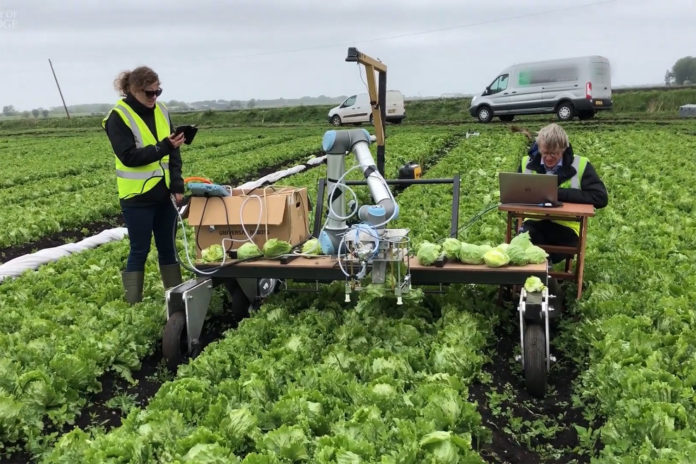Agricultural harvesting is one area of the industry that has always made new technological advances. Some crops are relatively easy to harvest mechanically at large scale for decades, but many other crops still require painstaking human labors to harvest.
Iceberg lettuce, the most common type of lettuce grown in the UK, is one such crop that has proved resistant to automation so far. The crop grows relatively flat to the ground, can easily damage and need to be cut at precise points, and hence presents a novel challenge for robotic harvesting.
Now, a team of engineers from the University of Cambridge has developed a robot called “Vegebot,” that can autonomously identify and harvest iceberg lettuce. This vegetable picking robot was initially trained using a machine-learning algorithm that helps it to determine whether particular lettuce is healthy and ready to be harvested, in a variety of field conditions.
In cooperation with the local fruit and vegetable co-operative ‘G’s Growers,’ the team has tested the robot successfully in various fields. “Every field is different, every lettuce is different,” said co-author Simon Birrell from Cambridge’s Department of Engineering. “But if we can make a robotic harvester work with iceberg lettuce, we could also make it work with many other crops.”
The computerized vision system of the Vegebot enables it to analyze plants, identify them within its field of vision and determine whether they’re ready to be harvested. Then, using integrated the complex cutting system, the robot finally cuts the lettuce from the rest of the plant without crushing it so that it is ‘supermarket ready’.
Researchers developed a machine-learning algorithm and then trained it – using the images of lettuces that were captured by the overhead camera on the Vegebot – to recognize different types of lettuce in the lab.
The team then moved the robot to the real-life field conditions and trained it in the field, in a variety of weather conditions, on thousands of real lettuces.
“For a human, the entire process takes a couple of seconds, but it’s a really challenging problem for a robot,” said co-author Josie Hughes.
A second camera on the Vegebot is positioned near the cutting blade and helps ensure a smooth cut. The researchers were also able to adjust the pressure in the robot’s gripping arm so that it held the lettuce firmly enough not to drop it, but not so firm as to crush it. The force of the grip can be adjusted for other crops.
“We wanted to develop approaches that weren’t necessarily specific to iceberg lettuce so that they can be used for other types of above-ground crops,” said Dr. Fumiya Iida, who leads the team behind the research.
The resultant system showed an effective identification result at 91% localized success rate. However, the system still needs to work before it can be translated into a commercial solution, with a particularly high damage rate of around 38 percent reported, which according to researchers did not meet supermarket standards but they still remained edible.
Another hurdle is its speed, the robot takes an average 32 seconds to pick each lettuce, which is much slower than an average human picker. But the researchers suggest lighter production materials should speed up this process.
On the other hand, in future, robotic harvesters could help address problems with labor shortages in agriculture, and could also help reduce food waste – though it may also put migrant workers out of a job.
“We’re also collecting lots of data about lettuce, which could be used to improve efficiency, such as which fields have the highest yields,” said Hughes. “We’ve still got to speed our Vegebot up to the point where it could compete with a human, but we think robots have lots of potential in agri-tech.”
The results are published in the Journal of Field Robotics.
